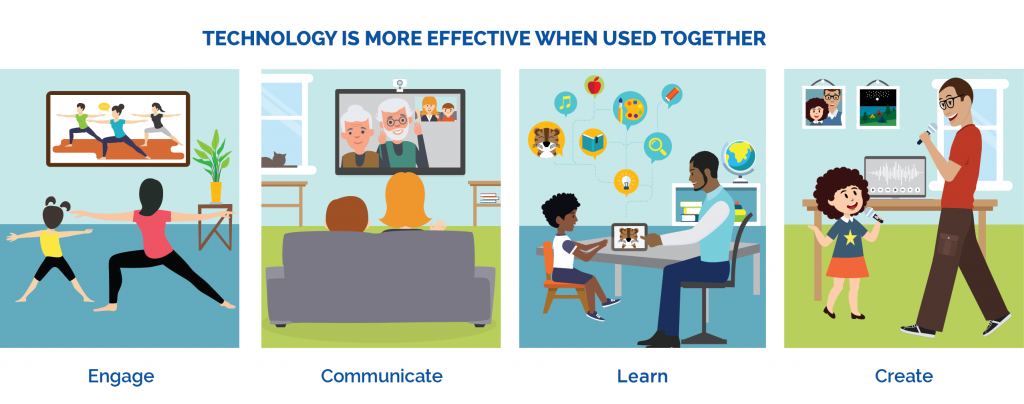Effects of Technology in Early Childhood
Technology has become part and parcel of people’s everyday lives, including children who have been exposed to media at home and school environments. The number of children interacting with technology devices has recently increased, and over 95% of children aged below nine years access technology (Sarama & Clements, 2020). It has prepared them for the 21st century by giving them real vast world experiences within home and classroom settings. Technology is highly commendable in early childhood as it could have positive effects on physical, social, emotional, cognitive, literacy, and language skills of child development areas.
Technology has provided new opportunities and a conducive environment for social, emotional development for young students to learn, interact and communicate with others. According to Oliemat et al. (2018), children who use shared devices such as computers and play cooperatively in their early years have shown to have improved social interactions. The research found out that children were likely to have a conversation, more interest, and positive feelings when they worked on computers with others than when doing puzzles. Thus, improving their collaboration, critical thinking, inclusion, and problem-solving skills. When used correctly, technology can enhance social interactions in children.
In the physical development aspect, technology enhances motor development. For instance, when using touch screen devices, children demonstrate physical development. According to studies, toddlers’ demonstrated this improvement when tapping, dragging, banging, pinching, and swiping the screen (Sarama & Clements, 2020). This shows that children need to actively engage in playing with technological devices by using hands instead of just watching or observing them. However, other researchers have refuted the opinions suggesting possible adverse effects of technology on the physical development of young children. There are concerns about the overall health and physical development of children who spend more time on screen than obesity (Oliemat et al., 2018). if the time spent on technological devices is not regulated, it is likely to have adverse effects on their growth and development; thus, parents and teachers are advised to follow screen time recommendations from research and health experts.
Moreover, technology could impact children’s cognitive development by improving their concentration, memory, curiosity, and thinking skills. During the stage of birth to 10 years, children’s cognitive and social skills develop fast through exploring and learning; thus, technology devices will boost their skills during this stage (Sarama & Clements, 2020). Further, young students can use technology to find answers to their questions, thus focusing on more critical thinking and complex tasks. Technology devices can also help to improve and support children with cognitive and physical impairments to overcome challenges in school and home settings. For instance, assistive technology has proved to help children with attention hyperactivity disorder strengthen their cognitive development using computer games used to improve behavior and organizational skills (Sarama & Clements, 2020). The technology has also helped the children diagnosed with ADHD to self-monitor their hyperactivity and impulses; thus, strengthening their development.
Technology also has an impact on children’s language development. During early childhood, vocabulary, including expressive and receptive language, is critical. Since it is used to communicate in different ways, such as through videos, pictures, sound, and symbols, it helps children be more creative in their communication, even those who do not know how to read and write yet (Oliemat et al., 2018). For instance, children who watch cartoons or other children’s programs gain many communication skills to acquire vast vocabulary early on from other children. Additionally, teachers who use digital tools provide children with a voice to communicate, such as those who use Speech Sound Disorders (SSD) to help preschool kids with speech delays to succeed in the classroom environment. These digital devices can also aid the children with this condition to communicate their needs, wants, and feelings with their peers. Other devices that can boost children’s communication include computers and phones, which they observe being used in their day-to-day lives being used by adults.
Children who use technology in studying are likely to improve their mathematical skills. In early childhood, kids use number operations and concepts, compare and contrast, explore and describe shapes, and demonstrate patterns. However, many students struggle with math to the extent of many developing a negative attitude towards the subject. In this case, digital math games can be used by teachers in Game-based learning to eliminate the fear and negative mindset (Higgins et al., 2017). According to research, the games highly motivate children to learn and practice basic mathematical skills. Thus, technology should be integrated into the classroom to provide increased literacy, enjoyment, engagement, and collaboration among children.
Technology should be used in early childhood to boost physical, social, emotional, cognitive, literacy, and language development. Parents and children should follow experts’ recommendations in integrating it in the children’s growth and development process. The digital tools used should be balanced both at school and home settings in order to be successful digital consumers







